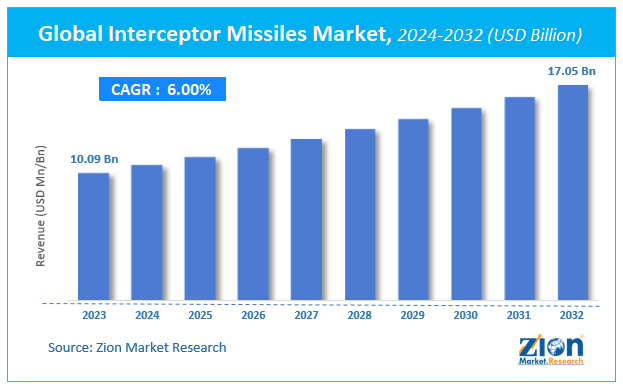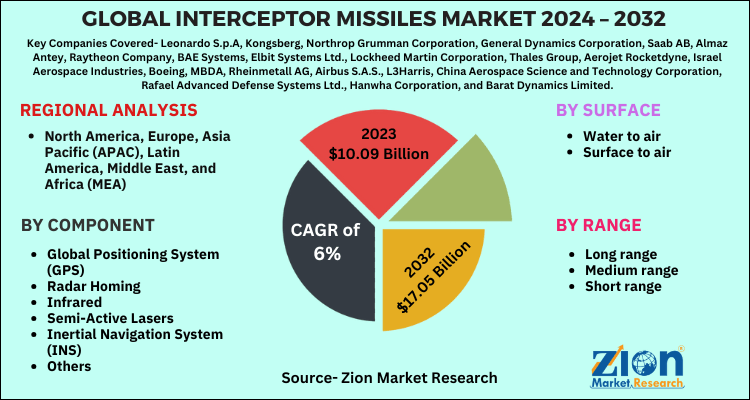Interceptor Missiles Market Size, Share Report, Analysis, Trends, Growth 2032

Interceptor Missiles Market - By Surface (Water To Air and Surface To Air), By Range (Long Range, Medium Range, and Short Range), By Component (Global Positioning System (GPS), Radar Homing, Infrared, Semi-Active Lasers, Inertial Navigation System (INS), and Others), and By Region: Global Industry Perspective, Market Size, Statistical Research, Market Intelligence, Comprehensive Analysis, Historical Trends, and Forecasts, 2024-2032
| Market Size in 2023 | Market Forecast in 2032 | CAGR (in %) | Base Year |
|---|---|---|---|
| USD 10.09 Billion | USD 17.05 Billion | 6% | 2023 |
Interceptor Missiles Market Insights
According to Zion Market Research, the global Interceptor Missiles Market was worth USD 10.09 Billion in 2023. The market is forecast to reach USD 17.05 Billion by 2032, growing at a compound annual growth rate (CAGR) of 6% during the forecast period 2024-2032. The report offers a comprehensive analysis of the market, highlighting the factors that will determine growth, potential challenges, and opportunities that could emerge in the Interceptor Missiles industry over the next decade.
The report covers an in-depth analysis of the strategies adopted by major competitors in the global interceptor missiles market. To understand the competitive landscape in the interceptor missiles market, an analysis of Porter’s Five Forces model is also included. The research study comprises of market attractiveness analysis, wherein all the segments are benchmarked on the basis of their market size and growth rate.
The research study provides a decisive view on the global interceptor missiles market based on surface, range, component, and region. All the segments of the market have been analyzed based on the past, present, and future trends. The market is estimated from 2024 to 2032.
Interceptor Missiles Market: Overview
Interceptor missiles are defense systems designed to detect, track, and destroy incoming ballistic missiles, aircraft, or other projectiles before they reach their intended target. These missiles are a critical part of a nation's air and missile defense strategy, providing protection against threats such as long-range missiles or airstrikes. Interceptor missiles work by targeting the incoming missile in mid-flight, often using advanced radar and guidance systems to ensure precision.
Advantages of interceptor missiles include their ability to protect critical infrastructure and civilian populations from potentially devastating attacks, enhancing national security. They also serve as a deterrent to adversaries, making it less likely for an attack to occur.
However, disadvantages exist. Interceptor missile systems can be expensive to develop and maintain, requiring advanced technology and significant financial investment. Additionally, they are not always 100% effective, especially against sophisticated or overwhelming missile attacks. Furthermore, their deployment can escalate tensions between countries, potentially leading to arms races or conflicts.
Interceptor Missiles Market: Growth Factors
The key factor that would eventually escalate the growth of the global interceptor market is the rising involvement of regional governments to enhance their interceptor missile capabilities and secure their political standard across the globe. Moreover, the growing R&D activities conducted by the industry players and surging technological advancements are flourishing the global market.
The Asia Pacific attained the foremost position in the global interceptor missiles market by capturing around one-fourth revenue share of the global market in 2024. The regional market is escalating due to the growing efforts of the public to support the defense sector of the nations.
The growth of the interceptor missiles market is driven by several key factors. Rising geopolitical tensions and the increasing threat of ballistic missile attacks have prompted many countries to invest heavily in advanced missile defense systems. Additionally, technological advancements in missile detection, tracking, and precision targeting have improved the effectiveness of interceptor missiles, boosting their adoption. The market is also fueled by government defense budgets, particularly in regions like North America, Europe, and Asia-Pacific, where national security concerns are high. Moreover, the growing demand for upgraded defense infrastructure to counter evolving missile threats, including hypersonic and stealth technologies, is driving further investments in interceptor missile development. Lastly, international collaborations and defense partnerships are fostering R&D efforts that contribute to market expansion.
Interceptor Missiles Market: Segmentation
The report encompasses the comprehensive analytical study of the global interceptor missiles market by segmenting it on the basis of surface, range, component, and region. Based on surface,
By Surface, the global market is segmented into water to air and surface to air.
By Range, the market is categorized into long range, medium range, and short range.
Component-wise, the global market is bifurcated into global positioning system (GPS), radar homing, infrared, semi-active lasers, inertial navigation system (INS), and others.
The regional segmentation comprises the past, present, and estimated demand for the Middle East & Africa, North America, Asia Pacific, Latin America and Europe. The regional segment is further split into the U.S., Canada, Mexico, UK, France, Germany, China, Japan, India, South Korea, Brazil, and Argentina among others.
Interceptor Missiles Market: Report Scope
| Report Attributes | Report Details |
|---|---|
| Report Name | Interceptor Missiles Market |
| Market Size in 2023 | USD 10.09 Billion |
| Market Forecast in 2032 | USD 17.05 Billion |
| Growth Rate | CAGR of 6% |
| Number of Pages | 110 |
| Key Companies Covered | Leonardo S.p.A, Kongsberg, Northrop Grumman Corporation, General Dynamics Corporation, Saab AB, Almaz Antey, Raytheon Company, BAE Systems, Elbit Systems Ltd., Lockheed Martin Corporation, Thales Group, Aerojet Rocketdyne, Israel Aerospace Industries, Boeing, MBDA, Rheinmetall AG, Airbus S.A.S., L3Harris, China Aerospace Science and Technology Corporation, Rafael Advanced Defense Systems Ltd., Hanwha Corporation, and Barat Dynamics Limited |
| Segments Covered | By Surface, By Component, And By Region |
| Regions Covered | North America, Europe, Asia Pacific (APAC), Latin America, Middle East, and Africa (MEA) |
| Base Year | 2023 |
| Historical Year | 2018 to 2022 |
| Forecast Year | 2024 - 2032 |
| Customization Scope | Avail customized purchase options to meet your exact research needs. Request For Customization |
Global Interceptor Missiles Market Key Players
Some of the essential players flourishing the global interceptor missiles market, but not restricted to include
- Leonardo S.p.A
- Kongsberg
- Northrop Grumman Corporation
- General Dynamics Corporation
- Saab AB
- Almaz Antey
- Raytheon Company
- BAE Systems
- Elbit Systems Ltd.
- Lockheed Martin Corporation
- Thales Group
- Aerojet Rocketdyne
- Israel Aerospace Industries
- Boeing
- MBDA
- Rheinmetall AG
- Airbus S.A.S.
- L3Harris
- China Aerospace Science and Technology Corporation
- Rafael Advanced Defense Systems Ltd.
- Hanwha Corporation
- Barat Dynamics Limited
The global interceptor missiles market is segmented as:
Global Interceptor Missiles Market: Surface Segmentation Analysis
- Water to air
- Surface to air
Global Interceptor Missiles Market: Range Segmentation Analysis
- Long range
- Medium range
- Short range
Global Interceptor Missiles Market: Component Segmentation Analysis
- Global Positioning System (GPS)
- Radar Homing
- Infrared
- Semi-Active Lasers
- Inertial Navigation System (INS)
- Others
Global Interceptor Missiles Market: Regional Segmentation Analysis
- North America
- The U.S.
- Canada
- Europe
- France
- The UK
- Spain
- Germany
- Italy
- Rest of Europe
- Asia Pacific
- China
- Japan
- India
- South Korea
- Southeast Asia
- Rest of Asia Pacific
- Latin America
- Brazil
- Mexico
- Rest of Latin America
- Middle East & Africa
- GCC
- South Africa
- Rest of Middle East & Africa
Table Of Content
Methodology
FrequentlyAsked Questions
Interceptor missiles are defense systems designed to detect, track, and destroy incoming ballistic missiles, aircraft, or other projectiles before they reach their intended target. These missiles are a critical part of a nation's air and missile defense strategy, providing protection against threats such as long-range missiles or airstrikes. Interceptor missiles work by targeting the incoming missile in mid-flight, often using advanced radar and guidance systems to ensure precision.
The major drivers of the industry, such as the growth in the number of deployed or active missile defence systems, rise in the stockpile of interceptor missiles, and the growth in the number of automatic launch centres, are expected to aid the market growth.
According to a study, the global interceptor missiles Industry size was $10.09 Billion in 2023 and is projected to reach $17.05 Billion by the end of 2032.
The global interceptor missiles market is expected to grow at a CAGR of 6% during the forecast period.
The major products in the industry are land-to-air missile and ship-to-air missile.
The major players in the industry are Leonardo S.p.A, Kongsberg, Northrop Grumman Corporation, General Dynamics Corporation, Saab AB, Almaz Antey, Raytheon Company, BAE Systems, Elbit Systems Ltd., Lockheed Martin Corporation, Thales Group, Aerojet Rocketdyne, Israel Aerospace Industries, Boeing, MBDA, Rheinmetall AG, Airbus S.A.S., L3Harris, China Aerospace Science and Technology Corporation, Rafael Advanced Defense Systems Ltd., Hanwha Corporation, and Barat Dynamics Limited.
The global interceptor missiles market report covers the geographical market along with a comprehensive competitive landscape analysis. It also includes cash flow analysis, profit ratio analysis, market basket analysis, market attractiveness analysis, sentiment analysis, PESTEL analysis, trend analysis, SWOT analysis, trade area analysis, demand & supply analysis, Porter’s five force analysis, and value chain analysis.
Choose License Type
RelatedNews
HappyClients
Zion Market Research
Tel: +1 (302) 444-0166
USA/Canada Toll Free No.+1 (855) 465-4651
3rd Floor,
Mrunal Paradise, Opp Maharaja Hotel,
Pimple Gurav, Pune 411061,
Maharashtra, India
Phone No +91 7768 006 007, +91 7768 006 008
US OFFICE NO +1 (302) 444-0166
US/CAN TOLL FREE +1 (855) 465-4651
Email: sales@zionmarketresearch.com
We have secured system to process your transaction.
Our support available to help you 24 hours a day, five days a week.
Monday - Friday: 9AM - 6PM
Saturday - Sunday: Closed







